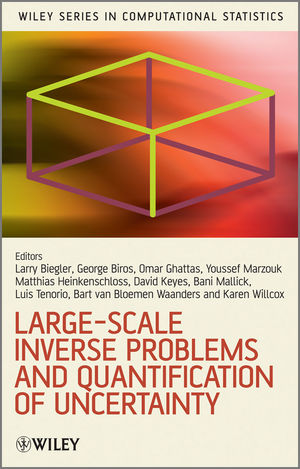Large-Scale Inverse Problems and Quantification of UncertaintyISBN: 978-0-470-69743-6
Hardcover
388 pages
November 2010
 |
||||||
1.1 Introduction
1.2 Statistical Methods
1.3 Approximation Methods
1.4 Kalman Filtering
1.5 Optimization
2 A Primer of Frequentist and Bayesian Inference in Inverse
Problems
2.1 Introduction
2.2 Prior Information and Parameters: What do you know, and what do
you want to know?
2.3 Estimators: What can you do with what you measure?
2.4 Performance of estimators: How well can you do?
2.5 Frequentist performance of Bayes estimators for a BNM
2.6 Summary
Bibliography
3 Subjective Knowledge or Objective Belief? An Oblique Look to
Bayesian Methods
3.1 Introduction
3.2 Belief, information and probability
3.3 Bayes' formula and updating probabilities
3.4 Computed examples involving hypermodels
3.5 Dynamic updating of beliefs
3.6 Discussion
Bibliography
4 Bayesian and Geostatistical Approaches to Inverse Problems
4.1 Introduction
4.2 The Bayesian and Frequentist Approaches
4.3 Prior Distribution
4.4 A Geostatistical Approach
4.5 Concluding
Bibliography
5 Using the Bayesian Framework to Combine Simulations and Physical
Observations
for Statistical Inference
5.1 Introduction
5.2 Bayesian Model Formulation
5.3 Application: Cosmic Microwave Background
5.4 Discussion
Bibliography
6 Bayesian Partition Models for Subsurface Characterization
6.1 Introduction
6.2 Model equations and problem setting
6.3 Approximation of the response surface using the Bayesian
Partition Model and two-stage
MCMC
6.4 Numerical results
6.5 Conclusions
Bibliography
7 Surrogate and reduced-order modeling: a comparison of approaches
for large-scale
statistical inverse problems
7.1 Introduction
7.2 Reducing the computational cost of solving statistical inverse
problems
7.3 General formulation
7.4 Model reduction
7.5 Stochastic spectral methods
7.6 Illustrative example
7.7 Conclusions
Bibliography
8 Reduced basis approximation and a posteriori error estimation
for parametrized
parabolic PDEs; Application to real-time Bayesian parameter
estimation
8.1 Introduction
8.2 Linear Parabolic Equations
8.3 Bayesian Parameter Estimation
8.4 Concluding Remarks
Bibliography
9 Calibration and Uncertainty Analysis for Computer Simulations
with Multivariate
Output
9.1 Introduction
9.2 Gaussian Process Models
9.3 Bayesian Model Calibration
9.4 Case Study: Thermal Simulation of Decomposing Foam
9.5 Conclusions
Bibliography
10 Bayesian Calibration of Expensive Multivariate Computer
Experiments
10.1 Calibration of computer experiments
10.2 Principal component emulation
10.3 Multivariate calibration
10.4 Summary
Bibliography
11 The Ensemble Kalman Filter and Related Filters
11.1 Introduction
11.2 Model Assumptions
11.3 The Traditional Kalman Filter (KF)
11.4 The Ensemble Kalman Filter (EnKF)
11.5 The Randomized Maximum Likelihood Filter (RMLF)
11.6 The Particle Filter (PF)
11.7 Closing Remarks
11.8 Appendix A: Properties of the EnKF Algorithm
11.9 Appendix B: Properties of the RMLF Algorithm
Bibliography
12 Using the ensemble Kalman Filter for history matching and
uncertainty quantification
of complex reservoir models
12.1 Introduction
12.2 Formulation and solution of the inverse problem
12.3 EnKF history matching workflow
12.4 Field Case
12.5 Conclusion
Bibliography
13 Optimal Experimental Design for the Large-Scale Nonlinear
Ill-posed Problem of
Impedance Imaging
13.1 Introduction
13.2 Impedance Tomography
13.3 Optimal Experimental Design - Background
13.4 Optimal Experimental Design for Nonlinear Ill-Posed
Problems
13.5 Optimization Framework
13.6 Numerical Results
13.7 Discussion and Conclusions
Bibliography
14 Solving Stochastic Inverse Problems: A Sparse Grid Collocation
Approach
14.1 Introduction
14.2 Mathematical developments
14.3 Numerical Examples
14.4 Summary
Bibliography
15 Uncertainty analysis for seismic inverse problems: two practical
examples
15.1 Introduction
15.2 Traveltime inversion for velocity determination.
15.3 Prestack stratigraphic inversion
15.4 Conclusions
Bibliography
16 Solution of inverse problems using discrete ODE adjoints
16.1 Introduction
16.2 Runge-Kutta Methods
16.3 Adaptive Steps
16.4 Linear Multistep Methods
16.5 Numerical Results
16.6 Application to Data Assimilation
16.7 Conclusions
Bibliography
TBD



